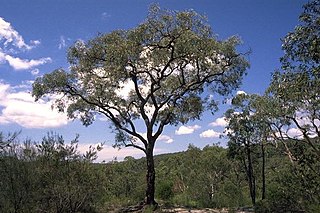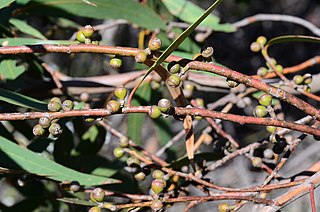
Eucalyptus radiata, commonly known as the narrow-leaved peppermint or Forth River peppermint, is a species of tree that is endemic to south-eastern Australia. It has rough, fibrous to flaky bark on the trunk and larger branches, smooth grey bark on the thinner branches, lance-shaped to curved or almost linear leaves, flower buds in groups of eleven to twenty or more, white flowers and cup-shaped, hemispherical or shortened spherical fruit.

Eucalyptus smithii, commonly known as the gully gum, gully peppermint, blackbutt peppermint, or ironbark peppermint, is a species of medium-sized to tall tree, sometimes a mallee, that is endemic to southeastern Australia. It has rough, compact bark on the trunk, smooth ribbony bark above, narrow lance-shaped adult leaves, flower buds in groups of seven, white flowers and cup-shaped, bell-shaped or hemispherical fruit.

Eucalyptus squamosa, commonly known as scaly bark, is a species of small to medium-sized tree that is endemic to the Sydney region in New South Wales. It has rough, tessellated, fibrous or flaky bark, lance-shaped or curved adult leaves, flower buds in groups of seven, nine or eleven, white flowers and cup-shaped or hemispherical fruit.

Eucalyptus aromaphloia, commonly known as Creswick apple-box, scented bark or scent-bark, is a species of plant in the myrtle family that is endemic to Victoria. It is a tree with rough, densely fibrous bark on the trunk and branches, lance-shaped or curved adult leaves, oval to spindle-shaped flower buds in groups of seven, white flowers and conical to hemispherical fruit.

Eucalyptus consideniana, commonly known as yertchuk, is a species of plant in the myrtle family and is endemic to south-eastern Australia. It is a tree with rough, fibrous, sometimes prickly bark on the trunk and larger branches, smooth grey bark above, lance-shaped or curved adult leaves, flower buds in groups of between eleven and nineteen, white flowers and conical to hemispherical fruit.
Eucalyptus croajingolensis, commonly known as the East Gippsland peppermint or Gippsland peppermint, is a species of tree that is endemic to southeastern Australia. It has rough, short-fibrous bark on the trunk and larger branches, sometimes smooth bark on the thinner branches, lance-shaped to curved adult leaves, flower buds in groups of nine or more, white flowers and hemispherical to cup-shaped fruit.

Eucalyptus dunnii, commonly known as Dunn's white gum or simply white gum, is a species of medium-sized to tall tree that is endemic to eastern Australia. It has rough bark near the base, smooth white to cream-coloured bark above, lance-shaped to curved adult leaves, flower buds in groups of seven, white flowers and cup-shaped, conical or hemispherical fruit.
Eucalyptus ignorabilis is a species of small to medium-sized tree that is endemic to southeastern Australia. It has rough, fibrous bark on the trunk and branches, lance-shaped to curved adult leaves, flower buds in groups of seven, white flowers and cup-shaped to hemispherical fruit. It is found in far southeastern New South Wales and eastern Victoria.
Eucalyptus retinens, commonly known as Hillgrove box, is a species of tree that is endemic to the Northern Tablelands of New South Wales. It has rough, fibrous or flaky bark on the trunk and larger branches, smooth bark on the thinner branches, lance-shaped adult leaves, flower buds in groups of seven, white flowers and cup-shaped, cylindrical or hemispherical fruit.

Eucalyptus arcana, commonly known as the Mallee manna gum or Carpenter Rocks gum is a mallee that is endemic to South Australia. It has rough bark from the base of the trunk to the thinnest branches, lance-shaped, sometimes curved leaves, flower buds in groups of seven, white flowers and hemispherical fruit. It is only known from a single population near Carpenter Rocks.
Eucalyptus fulgens, commonly known as green scentbark, is a small to medium-sized tree that is endemic to Victoria, Australia.
Eucalyptus hawkeri is a species of mallee or slender tree that is endemic to Victoria, Australia. It has rough, flaky or fibrous bark on the lower trunk, smooth bark above, lance-shaped or curved adult leaves, flower buds in groups of between seven and eleven, white flowers and cylindrical or barrel-shaped fruit.

Eucalyptus rubiginosa is a species of tree that is endemic to Queensland. It has rough, fibrous bark, lance-shaped or curved adult leaves that are paler on the lower surface, flower buds in groups of nine or eleven, white flowers and cup-shaped or hemispherical fruit.
Eucalyptus litoralis, commonly known as Anglesea box, is a species of tree that is endemic to a small area in Victoria. It has rough but thin, fibrous bark on the trunk, smooth pale grey bark on the branches, lance-shaped to curved adult leaves, flower buds in groups of seven, white flowers and cup-shaped or barrel-shaped fruit.
Eucalyptus arenicola, commonly known as the Holey Plains peppermint or Gippsland Lakes peppermint, is a tree or mallee that is endemic to south-east coastal areas of Victoria. It has rough, fibrous bark on its trunk and branches, glossy green, lance-shaped adult leaves, club-shaped buds arranged in groups of eleven to twenty five, white flowers and cup-shaped to hemispherical fruit.
Eucalyptus molyneuxii is a species of small tree or mallee that is endemic to the Little Desert National Park area of Victoria. It has short-fibrous bark on varying amounts of its trunk and branches, smooth bark above, glossy green, lance-shaped adult leaves, flower buds arranged in groups of between eleven and fifteen, white flowers and cup-shaped or conical fruit.

Eucalyptus sabulosa, commonly known as Wimmera scentbark, is a species of small, spreading tree that is endemic to Victoria, Australia. It has fibrous or scaly bark on the trunk and branches, lance-shaped to curved adult leaves, flower buds in groups of seven, white flowers and oval to almost spherical fruit.
Eucalyptus silvestris is a species of mallee or small tree that is endemic to Victoria, Australia. It has rough, fibrous or flaky bark on the trunk and larger branches, smooth greyish brown bark above, glossy green, lance-shaped leaves, flower buds usually in groups of seven, white flowers and conical to cup-shaped fruit.
Eucalyptus wetarensis is a species of tree that is endemic to Wetar Island in Indonesia. It has rough, fibrous bark on the trunk and larger branches, lance-shaped or curved adult leaves, flower buds in groups of seven and bell-shaped to barrel-shaped fruit.
Eucalyptus yarriambiack is a species of small, spreading tree that is only known from a single population in Victoria, Australia. It has rough, fibrous to flaky bark on the trunk, smooth bark above, narrow lance-shaped to elliptical adult leaves, flower buds in groups of seven to eleven, white flowers and hemispherical to cup-shaped fruit.








